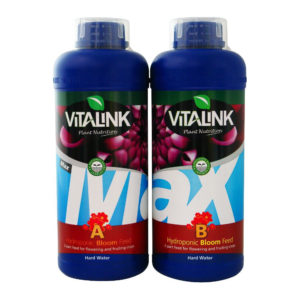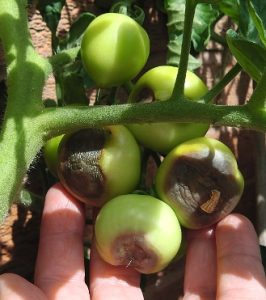One of the big issues when growing tomatoes, especially in containers, is calcium and Blossom End Rot (BER).
When our tomatoes suffer from BER, it could be for a number of reasons including…
- Poor quality soil – not enough calcium in the soil
- Interruption of the calcium supply to the plant
Calcium – What’s The Solution?
When calcium is mixed in its liquid form with some nutrients, it precipitates, like rain out of the clouds. In other words, it drops out of the solution and will eventually create a white film around the sides of the container it is mixed in.
Tomorite, a liquid feed, doesn’t contain calcium because of the reason stated above.
Chempak Standard Tomato Food does contain calcium because it comes in a dry form.
So how is this important for me?
If you are in a soft water area, that’s an area with low calcium in the tap water, it’s best to use Chempak Standard Tomato Food because it contains calcium.
If you are in a hard water area, Tomorite will be fine because the extra calcium is coming from your tap as well as the soil you are using, assuming that your compost/soil already contains calcium.
Compost with limestone contains calcium
Most good quality potting composts will contain enough calcium in the form of ground limestone to keep tomato plants happy and tomatoes free from Blossom End Rot.
pH buffers
Limestone is used to raise the pH of compost, to offset the low pH of peat – and end up with a pH somewhere in the middle – between 6.0 and 7.0. The best soil pH for growing tomatoes is around 6.8.
Peat free compost
If buying peat free compost this season, be aware that limestone, which is normally added to compost that contains peat, to counteract the low pH of peat (see above), may not have been added, especially if it is low quality.
If you’ve experienced Blossom End Rot when growing in peat free compost, it is wise to add extra calcium by foliar spraying.

Why is foliar spraying best and not adding calcium directly to the soil?
Too much calcium in the soil can prevent the uptake of potassium – you may end up with BER free tomatoes, but it may take a lot longer for them to mature without enough potassium available.
So what’s the solution?
A regular spray of calcium when plants are fruiting will provide a quick way to get calcium into a plant’s system without disturbing the nutrient balance of the soil.
It’s a case of hedging our bets – if there is already plenty of calcium in the soil or potting compost, an extra foliar spray won’t hurt. If we add calcium to the soil when there is already plenty there, we risk the potassium lock up mentioned above.
It is always worth using calcium as a foliar spray weekly, after flowers have started to set fruit, just in case!
If you suffer each season from Blossom End Rot
If you are in a soft water area, use a liquid feed and regularly suffer from Blossom End Rot, you may like to move to a dry feed that contains calcium, or add extra calcium as a foliar spray. As mentioned above, too much calcium in the soil can prevent potassium uptake and stop your tomatoes ripening!
 Two part feeds
Two part feeds
To avoid the problem of calcium not mixing with other nutrients, liquid nutrients are often kept in two seperate containers A and B as in the case of the Quadgrow Planter.
When you buy a Quadgrow Planter for example, they provide two containers with a powder in each to add your own water.
One is the main nutrient formula and the other is calcium. These are added separately to the watering can or water tank.
The nutrients are then watered into the soil before precipitation occurs.
Of course you don’t really need a two part feed – when growing in soil – as long as you choose a good potting compost, foliar spray with calcium and make sure that your soil never dries out.

Tap water
If you live in a hard water area your plants are less likely to suffer from calcium deficiency. You know you are in a hard water area when kettles rattle because of a calcium deposit – and your washing machine lasts longer with Calgon!
The importance of calcium
Calcium isn’t just important in order to avoid Blossom End Rot, it is used in cell wall formation and is required in many other aspects of growth.
Calcium doesn’t move around as needed
Because it is immobile (doesn’t easily move around a plant’s system as nitrogen or magnesium does for example), deficiency symptoms show first in new growth.
Pale new growth
Young leaves at the growing tip can lose their colour and plants become stunted, stiff and woody.
Pale lower leaves
The reason why lower leaves often look pale green is because nitrogen and magnesium (both mobile) are moved from the lower leaves to the growing tip if a plant isn’t able to take up enough of these nutrients through the roots.
Plants are able to “rob Peter to pay Paul” with mobile nutrients but not with calcium – an immobile nutrient.
This means that if there is an interruption to the intake of calcium through the roots – we get Blossom End Rot.
This can easily happen if he soil runs dry on a hot day and the main reason why keeping your soil moist at all times is so important.
To sum up
- Choose a good quality potting compost
- Foliar spray with calcium
- Make sure that your soil never dries out
The foliar spray could be made up of Chempak Calcium. Some gardeners use a mix of 50-50 water/skimmed milk – full fat milk will make your greenhouse smell like a dairy and could damage the skins of the tomatoes.
If you are making your own compost, egg shells provide a great source of calcium but they can take a some time to break down. If you are planting directly into garden soil or growing on an allotment, adding egg shells at the end of this season will provide calcium for next season. Bone meal is also a good source of calcium.
I hope that the above info. has given a few suggestions and ideas on how to make sure that your plants get enough calcium this season.
Regards,
Nick

Anonymous
hi nick
tried fantasia this year poor germination,out of 20 seeds only 6 made it and they don’t seem to be growing ,very slow and don’t look great,has anybody else tried them and how are they doing
cheers willie
Ted Devlin
Hi Nick.
I found week 10 very interesting; I’ve been plagued by BER for years.Been told it’s caused by over and under watering. I used to leave a dish of water under greenhouse pots to uptake water as required. Is this a good idea?
Regards,
Ted.
Nick
Hi Ted,
The problem with sitting a pot in water 24/7 is that the soil becomes saturated and the oxygen between the soil particles is removed.
Having a reservoir system such as with the Quadgrow or a wet/dry cycle as with the Autopot system prevents saturation and allows roots to absorb oxygen on a regular basis.
Regards,
Nick
David King
As i live in a hard water area (East Anglia) there is plenty of calcium in the water. What would happen if add lemon juice our water, to reduce the pH level? Do you think I’d have to water or spray extra calcium? Would I just carry on or add more lemon juice?
Nick
Hi David,
The lemon juice doesn’t remove the calcium, it just adjusts the pH. Not too important for plants grown in soil because the soil is buffered with peat and limestone (hopefully!). Peat free compost should have an alternative to lower the pH.
It’s always a good idea to give tomato plants a spray with calcium, just to make sure they have it when the tomatoes begin to swell.
Regards,
Nick
John Bowtell
Thank you Nick for all your helpful advice. Don’t know what we’d do without you. Long may your blossom ends never rot.
Nick
Thank you John … may your tomatoes always ripen!